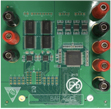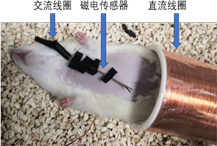-
Brain Implanted Devices
A large scale and high resolution neural single recording still remains challenging and obstructs a deeper understanding on brain’s function. Electroencephalogram (EEG) is widly used for large scale neural signal monitor but it lacks signal resolution. Light-field microscopy can achieve high resolution signal record. However, it can’t realize in-vivo recording. Our objective is to record a cluster of neural signal at a single-cell level in-vivo with a minimum invasion. The neural signal can be recorded by implanted dusts. Ultrasound is proved to be safe and has a relatively low attenuation in clinic applications. So the recorded signal is transmitted outside body by using ultrasound wave as medium. A out-side-body ultrasound phased array is employed to generate and focus ultrasound beams to supply dusts and acquire the backscattering signal.
The whole system consists of two parts:
- Implanted dust are designed in four layers: ultrasound transducer layer for energy harvest, integrated circuits layer for signal processing, magnetoelectric layer for neural interface and a magnetic tail which can provide a magnetic force to drive the dust.
- A out-side-body ultrasound phased array is employed to localize and communicate with the implanted dusts through Massive MIMO technology. Additionally, ultrasound beams are focused on different dusts to provide power supply.

 |
 |
|
 |
 |
|
|
|
|
|
| 声场测量设备 |
仿真结果 |
系统测试 |
超声波相控阵列控制单元 |
小鼠神经放电磁信号测试 |
-
Out-of-Body Part for Intermittent Power Delivery and Communication
As integrated circuit fabrication technology develops rapidly, implanted device for medical applications, neural science etc. becomes popular. However, communication and power supply for these devices still remain challenging as the size of implanted device scales down. Due to a high attenuation in tissue, electromagnetic wave is no more the best medium for data transmission. Ultrasound is proved to be safe in clinic and has a relatively low attenuation in tissue. Using ultrasound wave seems to be very promising to achieve communication and power supply for implanted device.
Our current work is to develop an ultrasound phased array which can generate and focus ultrasound beams on implanted device and acquire the backscattering signal. A power amplified module is designed on PCB to amplify the controlled signal generated by FPGA. The amplified signal is applied to ultrasound transducers yield in ultrasound beams. The received analog backscattering signal can be digitalized by an ADC and upload to PC by a FPGA.
Our future work will focus on developing localization algorithm for an in-vivo environment. Space division multiplexing and frequency division multiplexing technology will be used to maintain communication links with a large number of terminals. The signal to noise ration of received signal will be improved thanks to beamforming technology.
-
Brain Implanted Neural Dust for Human Machine Interface
Below this paragraph is a simplified block diagram of Neural Dust system. As you can see, the Dust contains several parts: Ultrasonic transducer is used to receive ultrasonic energy from the phased array out of body. Then, the received energy is rectified and stored by power management part, which can supply energy for the whole system. There is a specially designed neural interface to collect neural signal. Then, an LNA is used to amplify the signal to a few hundred millivolts. At last, The impedance modulation part uses the amplified signal to modulate the impedance of Ultrasonic circuit and hence, it also modulates the back-scatting wave. After that, we can get the neural signal outside the body.
